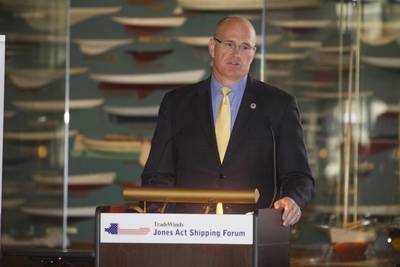Jones Act Fleet a Catalyst for Growth Says Jaenichen
At the inaugural recent Tradewinds Jones Act Forum, MARAD Acting Administrator Paul 'Chip' Jaenichen discussed the changes affecting the coastwise U.S.-flag maritime industry -- also known as the Jones Act fleet. Extracts follow:
Since its enactment, the Jones Act continues to ensure a level playing field for U.S. vessels moving cargo within the nation. The Act keeps skilled American mariners employed aboard American ships by requiring that products moved between U.S. ports be carried by U.S. vessels manned by U.S. crews. More recently, the Jones Act has been a catalyst for growth in the maritime industry and also our economy.
Supply boats, large tankers, and barge vessels are in high demand to support the production and movement of shale oil, a new, more abundant cargo source, between American coastwise ports. Currently 12 new self-propelled product and crude tankers are on order from American shipyards, with options to build more. In addition, more than 100 offshore vessels are on order at Gulf Coast shipyards, with the number of deep water rigs available in the Gulf of Mexico expected to increase by 25 percent by 2015.
That’s why this Administration has invested more than $150 million to boost U.S. shipyards that support production upgrades to increase capacity and competitiveness as well as shipyard efficiency.
It’s a wise investment. Since 2008, U.S. oil and natural gas production has increased overall and net imports of foreign oil and petroleum fell to their lowest level in nearly 20 years. We are now less reliant on oil imports than any time since 1993 with the U.S. on track to become the world’s largest oil producer by 2020.
And of course, increased production at our shipyards means middle-class jobs for Americans who not only build, but also operate these vessels. Additionally, the shipbuilding industry contributes more than $36 billion to our national economy.
The Obama Administration remains committed to our shipping industry and to the policies that sustain domestic trade. This productive industry has helped grow America’s economy.













